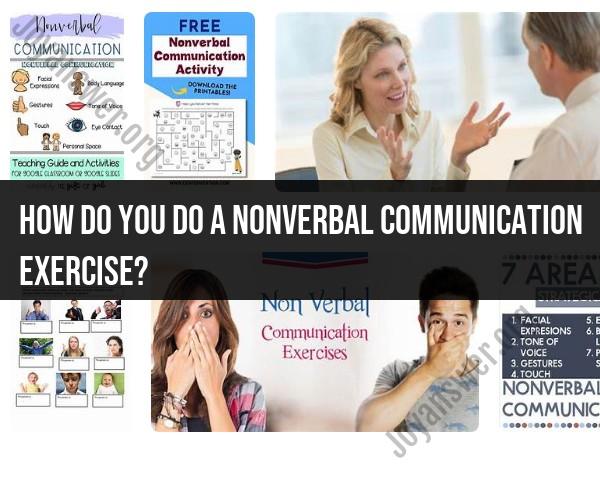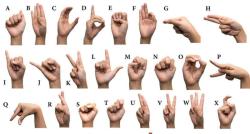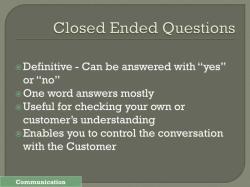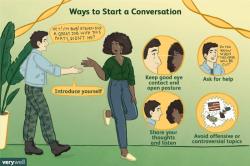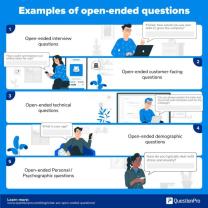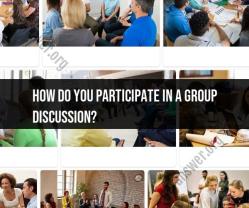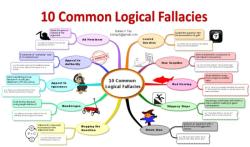How do you do a nonverbal communication exercise?
Nonverbal communication exercises are designed to help individuals develop and improve their understanding and use of nonverbal cues such as body language, facial expressions, gestures, and tone of voice. These exercises can be useful for improving interpersonal skills, building empathy, and enhancing communication. Here's how to engage in nonverbal communication exercises:
Mirror Exercise:
- Find a partner to work with.
- One person takes the lead as the "sender," while the other becomes the "receiver."
- The sender makes a series of nonverbal cues, such as facial expressions, hand gestures, and body postures.
- The receiver mirrors the sender's nonverbal cues as closely as possible.
- After a few minutes, switch roles so the receiver becomes the sender.
Emotion Charades:
- Write down various emotions on pieces of paper (e.g., happiness, anger, sadness, surprise).
- Place the emotion cards in a container.
- One person draws a card and must convey the chosen emotion without using words while the others guess the emotion being portrayed.
Group Observation:
- Form a group and have one person volunteer to be observed.
- The observed person should talk about a specific topic or share a personal story while the rest of the group observes their nonverbal cues.
- Afterward, discuss what nonverbal cues were noticed and how they influenced the message.
Video Analysis:
- Select a video clip of a public speaker, actor, or a scene from a movie or TV show.
- Watch the video as a group and pay close attention to the nonverbal cues of the people in the clip.
- Discuss the impact of the nonverbal cues on the communication.
Tone of Voice Exercise:
- Divide into pairs.
- One person shares a short story, statement, or question with a specific tone of voice (e.g., happy, angry, sad).
- The other person listens and identifies the tone of voice used.
Role-Playing:
- Create scenarios or scripts that involve different emotional situations.
- Participants take on different roles and act out the scenarios while focusing on conveying emotions through body language and facial expressions.
Self-Reflection:
- Record yourself speaking or delivering a message (you can use a smartphone or video camera).
- Watch the recording and pay attention to your nonverbal cues. Reflect on what messages your body language and facial expressions convey.
Interactive Storytelling:
- Sit in a circle.
- Start a story, and each person contributes a sentence or phrase to the narrative, using nonverbal cues to convey emotions and context.
Nonverbal Listening Exercise:
- In pairs, one person speaks about a topic while the other listens without interrupting.
- The listener uses nonverbal cues, such as nodding, maintaining eye contact, and showing empathy through facial expressions, to demonstrate active listening.
Trust Building Exercise:
- Blindfold one participant and have another participant guide them through an obstacle course or maze using only nonverbal cues (e.g., gentle touch, hand signals).
These exercises can be adapted and modified to suit the specific goals and needs of your group or your personal development. Nonverbal communication exercises are valuable for improving communication skills, enhancing emotional intelligence, and building stronger interpersonal connections.
How to conduct a nonverbal communication exercise to enhance interpersonal skills
To conduct a nonverbal communication exercise to enhance interpersonal skills, you will need to:
- Identify the specific nonverbal communication skills that you want to improve. This could include body language, eye contact, facial expressions, or tone of voice.
- Find or develop an exercise that targets the specific nonverbal communication skills that you want to improve. There are many resources available online and in libraries.
- Gather the materials and participants that you need for the exercise.
- Provide clear instructions and demonstrations to the participants.
- Allow the participants to practice the exercise.
- Provide feedback to the participants on their progress.
Key components of a nonverbal communication exercise
The key components of a nonverbal communication exercise are:
- A specific goal or objective. What nonverbal communication skills do you want to improve?
- Clear instructions and demonstrations. Participants should know what they are supposed to do and how to do it.
- Opportunities for practice. Participants should have the opportunity to practice the nonverbal communication skills that they are learning.
- Feedback. Participants should receive feedback on their progress so that they can make adjustments and improve.
Specific exercises for improving body language, eye contact, and facial expressions
Here are some specific exercises for improving body language, eye contact, and facial expressions:
- Body language:
- Stand up straight and make eye contact with the person you are speaking to.
- Avoid fidgeting or crossing your arms.
- Lean in slightly towards the person you are speaking to.
- Eye contact:
- Hold eye contact for 3-5 seconds at a time.
- Avoid looking down or away.
- Make eye contact with different people in a group.
- Facial expressions:
- Smile and nod your head to show that you are listening and engaged.
- Avoid frowning or looking bored.
- Make eye contact and smile when you are speaking.
How to assess progress and effectiveness in nonverbal communication
There are a few ways to assess your progress and effectiveness in nonverbal communication:
- Ask for feedback from others. Ask friends, family, or colleagues for feedback on your body language, eye contact, and facial expressions.
- Record yourself speaking and watch it back. This can help you to identify areas where you can improve.
- Practice with a mirror. This can help you to see how your body language, eye contact, and facial expressions appear to others.
Benefits of practicing nonverbal communication exercises in various personal and professional contexts
There are many benefits to practicing nonverbal communication exercises in various personal and professional contexts. Here are a few examples:
- Improved relationships: When you use effective nonverbal communication, you can build stronger relationships with friends, family, and colleagues.
- Increased confidence: When you are confident in your nonverbal communication skills, you will feel more confident in yourself overall.
- Enhanced communication skills: Nonverbal communication is an essential part of effective communication. By practicing nonverbal communication exercises, you can improve your overall communication skills.
- Greater success in the workplace: Effective nonverbal communication is essential for success in the workplace. When you use effective nonverbal communication, you can build rapport with clients, make a good impression on potential employers, and advance your career.
Overall, practicing nonverbal communication exercises can help you to enhance your personal and professional life. By improving your body language, eye contact, and facial expressions, you can build stronger relationships, increase your confidence, and improve your communication skills.
